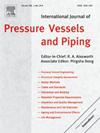Development, validation, and verification of multi-pass thermo-mechanical welding simulations using the open-source MOOSE framework: NeT TG4 benchmark weldment
IF 3
2区 工程技术
Q2 ENGINEERING, MECHANICAL
International Journal of Pressure Vessels and Piping
Pub Date : 2025-05-19
DOI:10.1016/j.ijpvp.2025.105560
引用次数: 0
Abstract
This study develops and validates a sequentially coupled thermo-mechanical welding simulation for the three-pass 316L stainless steel NeT TG4 benchmark weldment using the open-source Multiphysics Object-Oriented Simulation Environment (MOOSE) and the Nuclear Engineering Material model Library (NEML). A diffused ellipsoidal heat source was calibrated against thermocouple data and weld macrographs to accurately model the fusion zone geometry and transient thermal fields. Material hardening is represented using the Lemaitre-Chaboche mixed isotropic-kinematic hardening model, while four annealing models - no annealing, single-stage at 1050 °C and 1300 °C, and two-stage at 800 °C/1300 °C - were implemented to assess the impact of annealing models on the accuracy of the predicted welding-induced plasticity, distortions, and residual stresses. The predictions were validated against experimental measurements and benchmarked against results from commercial software, demonstrating that thermo-mechanical MOOSE welding simulations achieve comparable accuracy with enhanced computational efficiency. This work highlights the potential of using open-source finite element frameworks like MOOSE for advanced manufacturing simulations.
使用开源MOOSE框架:NeT TG4基准焊件开发、验证和验证多道热机械焊接模拟
本研究利用开源的多物理场面向对象仿真环境(MOOSE)和核工程材料模型库(NEML)开发并验证了316L不锈钢NeT TG4三道基准焊件的顺序耦合热-机械焊接仿真。利用热电偶数据和焊缝宏观图对扩散椭球热源进行了标定,以准确模拟熔合区的几何形状和瞬态热场。材料硬化使用Lemaitre-Chaboche混合各向同性-运动硬化模型来表示,而四种退火模型-不退火,单阶段1050°C和1300°C,以及两阶段800°C/1300°C -被实施,以评估退火模型对预测焊接引起的塑性,变形和残余应力的准确性的影响。通过实验测量验证了预测结果,并与商业软件的结果进行了基准测试,结果表明,热力学MOOSE焊接模拟在提高计算效率的同时达到了相当的精度。这项工作强调了使用开源有限元框架(如MOOSE)进行先进制造模拟的潜力。
本文章由计算机程序翻译,如有差异,请以英文原文为准。
求助全文
约1分钟内获得全文
求助全文
来源期刊
CiteScore
5.30
自引率
13.30%
发文量
208
审稿时长
17 months
期刊介绍:
Pressure vessel engineering technology is of importance in many branches of industry. This journal publishes the latest research results and related information on all its associated aspects, with particular emphasis on the structural integrity assessment, maintenance and life extension of pressurised process engineering plants.
The anticipated coverage of the International Journal of Pressure Vessels and Piping ranges from simple mass-produced pressure vessels to large custom-built vessels and tanks. Pressure vessels technology is a developing field, and contributions on the following topics will therefore be welcome:
• Pressure vessel engineering
• Structural integrity assessment
• Design methods
• Codes and standards
• Fabrication and welding
• Materials properties requirements
• Inspection and quality management
• Maintenance and life extension
• Ageing and environmental effects
• Life management
Of particular importance are papers covering aspects of significant practical application which could lead to major improvements in economy, reliability and useful life. While most accepted papers represent the results of original applied research, critical reviews of topical interest by world-leading experts will also appear from time to time.
International Journal of Pressure Vessels and Piping is indispensable reading for engineering professionals involved in the energy, petrochemicals, process plant, transport, aerospace and related industries; for manufacturers of pressure vessels and ancillary equipment; and for academics pursuing research in these areas.

 求助内容:
求助内容: 应助结果提醒方式:
应助结果提醒方式:


